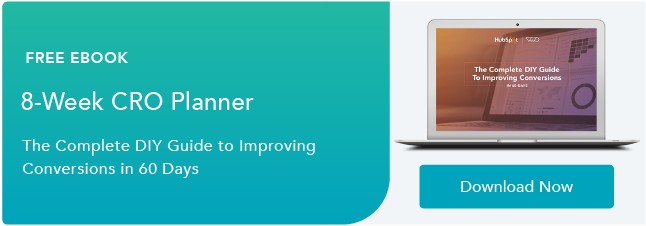As a marketer, a big part of your job is to convert qualified website visitors into leads. Simple enough.
More specifically, inbound marketing requires you to create remarkable content they'll want to trade their contact information for. From there, those leads turn into opportunities, who turn into customers and even promoters.
Clearly, conversions are a big deal. So how can you optimize yours? By creating conversion paths optimized to most effectively convert your ideal visitors into leads.
While not all conversion paths are identical and depend on the type of business they’re for, they have a few common attributes: a landing page, a call-to-action, a content offer or end point, and a thank you page.
- Landing page: A landing page is a specific page on your website designed to collect a visitor’s contact information in exchange for a resource, like a course, ebook, or other product.
- Call-to-action: A call-to-action is a section on a webpage or advertisement that persuades the visitor to act or do something. These can take the form of buttons prompting website visitors to sign up, subscribe, or buy a product.
- Thank you page: The thank you page shows your visitors that you appreciate them for taking a desired action. For example, a thank you page might appear after a visitor has signed up for a newsletter or filled out a form.
- End point: This may be in the form of a content offer, which is any material or resource given to a visitor in exchange for their contact information, completing the conversion path. These materials could be guides, ebooks, courses or other products. For e-commerce, instead of a content offer, a conversion path may end in a purchase.
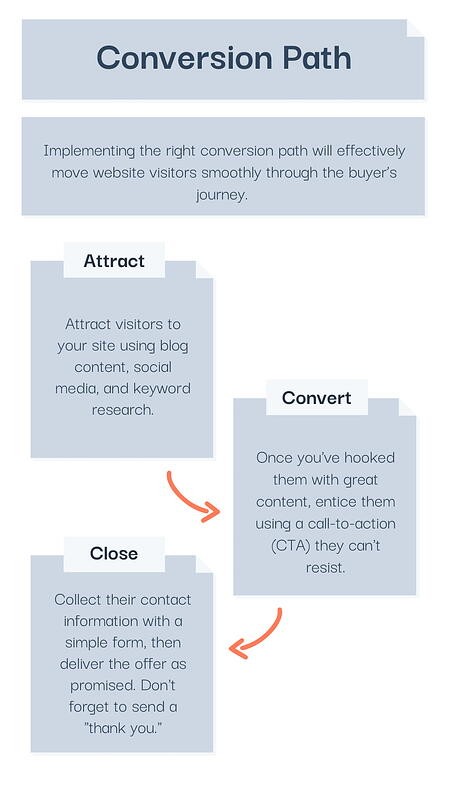
In order to convert into a lead, a visitor sees a content offer of interest to them (or product in the case of e-commerce), clicks on the call-to-action button to access that content, and is then taken to a landing page. On that landing page, the visitor can provide their information on a form in exchange for access to the offer itself. Upon submitting that form, the now-lead is taken to a thank you page where they receive the offer.
Voila! Conversion path complete.
By designing and implementing the right conversion paths, you can most effectively move website visitors through the buyer’s journey and help them become customers and promoters.
Conversion Path Example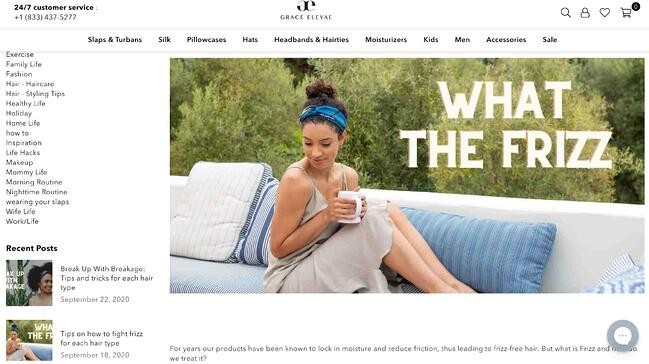
Let's say you've been lured to the landing page above after searching online for tips for preventing frizzy hair.
You're then prompted by a CTA (pictured below) that invites sign up for their email list in exchange for 10% of their products.
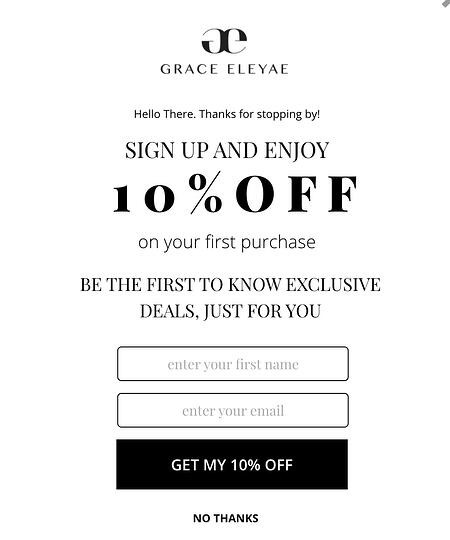 You decide you'd like to try one of their satin-lined caps to fight frizz and take them up on the offer.
You decide you'd like to try one of their satin-lined caps to fight frizz and take them up on the offer.
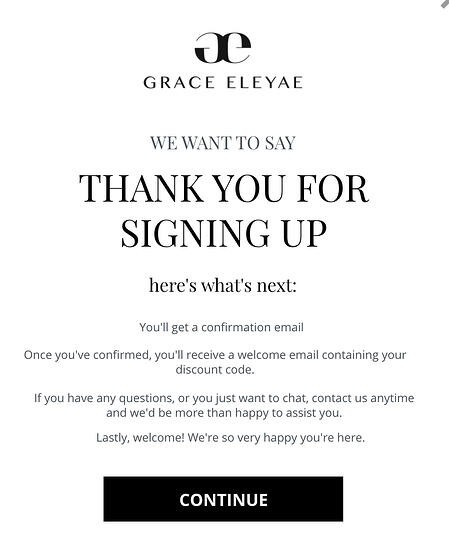 A thank you page pops up once you've filled out the form giving instructions on how to access your discount code. Once you get the code from your email, you use it to purchase one of their caps. Ta-da! The conversion path is complete.
A thank you page pops up once you've filled out the form giving instructions on how to access your discount code. Once you get the code from your email, you use it to purchase one of their caps. Ta-da! The conversion path is complete.
What makes a good conversion path?
Well as you might have guessed, you need content, a call-to-action, a landing page, and a thank you page. But with so many conversion paths out there on the internet for your potential customers to explore, it’s more important than ever to create the RIGHT paths — paths that your ideal customers are drawn to and most effectively convert the right visitors into leads.
What are the steps to creating a conversion path?
Let’s explore the key items you need in your inbound toolkit to create effective conversion paths that turn casual visitors into customers.
1. Attract your target audience with context-appropriate content.
Content is the fuel that powers effective inbound strategies—and it’s what you’ll use to convert those website visitors into leads. The good news is that content is everywhere! Content is what your website pages are filled with, what goes into your emails, and what’s hosted on your blog -- your website pages, emails, and blog are just vehicles to deliver that content.
Although content is in no short supply, in order for it to act as your inbound rocket fuel, you need to create the right content. As you can probably guess, the right content is optimized to appeal specifically to your buyer personas. It should focus on the challenges they’re trying to overcome and the goals they're looking to hit. Most of all, it should be relevant and interesting to them.
But here’s the kicker — it’s not enough to just create persona-specific content. That content needs to be relevant to your persona based on where they are in the buyer’s journey.
The buyer’s journey is the active research process your personas go through leading up to making a purchase — and specific content is more relevant to your personas at different stages of that journey. This is where the “context” piece comes in: It’s not enough to just create content for your personas. You have to make sure that content is relevant to what they’re interested in and hoping to learn more about.
Most visitors to your site are still at the very beginning stages of that journey — they might not even know what your product does or how it can help them. All they may know is that they have a problem or there’s an opportunity at hand. So, the content that will most appeal to your personas when they’re first visiting your website and converting a lead will generally be high-level and educational in nature.
In order to be an effective tool in your conversion path toolkit, make sure you have remarkable content tailored to your buyer personas and where they are in the buyer’s journey.
2. Create landing pages that speak to your personas.
After you’ve developed a remarkable content offer that speaks to both who your personas are and where they are in the buyer’s journey, the next step is to leverage that piece of content to convert website visitors into leads. That’s where landing pages come in.
Landing pages are specialized website pages whose sole purpose is to collect visitors’ contact information in exchange for something of value to them. Landing pages contain forms that potential leads must fill out and submit before getting access to your remarkable content offer. And like that offer, great landing pages must also be tailored to both who your personas are and where they are in the buyer’s journey.
In order to most effectively convert website visitors into leads, your landing pages must present the benefits of your offer that are most relevant to the particular problem your persona is experiencing — and discuss the aspects of that problem that are most important to where your persona is in the buyer’s journey.
Imagine, for example, you work at a pet store and have created an ebook on raising a puppy. Someone who’s at the beginning of the buyer’s journey probably won’t be too interested in downloading your ebook if your landing page talks all about how your ebook contains the best techniques for housebreaking. Instead, an effective landing page for this persona might highlight how your ebook discusses how to choose the right dog breed for you.
Great landing pages focus on both who your personas are and where they are in the buyer’s journey.
3. Use attention-grabbing calls-to-action.
While having a remarkable content offer and great landing page are key to creating a successful conversion path, your website visitors need a way to actually access that landing page in the first place. That’s where calls-to-action come in.
Calls-to-action or CTAs, are buttons you can embed throughout your website that advertise your content offers. When a visitor clicks on one of these calls-to-action, they’ll be taken to your landing page. In effect, every call-to-action you have on your website is the beginning of a conversion path.
To create calls-to-action that get those clicks and act as key steps within your conversion paths, you must ensure that the message displayed on your call-to-action aligns with the message on your landing page — and the content itself.
Great calls-to-action should be just that: action-oriented. Since their main objective is to garner clicks and direct people to landing pages, ensure that they’re click-worthy by using actionable language and colors that help them stand out from the rest of your website.
4. Close the deal with optimized thank you pages.
If a call-to-action is the beginning of a conversion path, a thank you page marks its end. Thank you pages are the final item you need in your inbound toolkit to lead your website visitors down a conversion path to become, well, a lead.
Thank you pages are specialized website pages from which your now-leads can download the offer promised by your call-to-action and landing page. They’re also an opportunity to move people further along in the buyer’s journey, by including things like additional calls-to-action that complement the offer you've just provided your lead.
Improving the Mobile Conversion Path Experience
Designing for mobile is no longer optional, it’s a must. According to a 2020 report from Global System for Mobile Communications Association (GSMA, formerly Groupe Spécial Mobile), nearly half the world’s population uses a mobile device to access the internet. By the end of 2019, 3.8 billion people were mobile internet users, an increase of 250 million users from the previous year.
With those numbers in mind, there’s a good chance visitors will access your website from their phone or tablet versus a desktop. If you want to create an effective conversion path, It’s imperative to consider the mobile user experience. Follow these steps to create a mobile conversion path that sets visitors up for success.
- Start with a responsive design: A responsive design adapts to both desktop and mobile devices by rendering the display differently based on screen size. Visitors won’t have to pinch or zoom in while browsing your website via mobile, which leads to a better user experience. Additionally, having a responsive design signals to Google that your site is mobile-friendly, which will help improve your rankings in search results for mobile users.
- Nix cluttered landing pages: When it comes to smaller screens, minimalism is a virtue. Having long-form, relevant content, images and video may translate well on desktop, but can be too busy for mobile devices. Avoid unnecessary text, images, and features that may make it difficult for visitors to find the information they’re looking for. Visitors can’t become leads if they can’t navigate your website. Consider the information most relevant to your audience, and leave out the rest.
- Keep CTAs to a minimum: As noted above, with smaller screens you’ll want to take extra care with how that real estate is allocated. Opt for one (or a few), clear call-to-action button as the main focus that your potential customers can easily find. Keep sign-up forms short, only asking for the information you absolutely need. Avoid burying the call-to-action at the bottom of the page after several paragraphs of text. In most cases, mobile users will not scroll down to the end of the page to see it.
As people become increasingly attached to their phones, taking the mobile user experience into account will improve your chances of converting more leads.
Conversion paths are invaluable in inbound marketing as they convert website visitors into leads. When done right, an effective conversion path can move leads beyond an initial conversion, ultimately turning them into customers.
Editor's note: This post was originally published in May, 2014 and has been updated for comprehensiveness.

